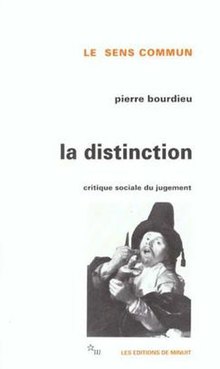La Distinction

Cover of the first edition
|
|
| Author | Pierre Bourdieu |
|---|---|
| Country | France |
| Language | French |
| Subject | Taste |
Distinction: A Social Critique of the Judgement of Taste (French: La Distinction) is a 1979 book by Pierre Bourdieu, based upon the author's empirical research from 1963 until 1968. A sociological report about the state of French culture, Distinction was first published in English translation in 1984. In 1998 the International Sociological Association voted Distinction as one of the ten most important sociology books of the 20th century.
Bourdieu proposes that those with a high volume of cultural capital - non-financial social assets, such as education, which promote social mobility beyond economic means - are most likely to be able to determine what constitutes taste within society. Those with lower volumes of overall capital accept this taste, and the distinction of high and low culture, as legitimate and natural, and thus accept existing restrictions on conversion between the various forms of capital (economic, social, cultural). Those with low overall capital are unable to access a higher volume of cultural capital because they lack the necessary means to do so. This could mean lacking the terminology to describe or methods of understanding classical artwork, due to features of their habitus, for example. Bourdieu asserts in this respect that 'working-class people expect objects to fulfil a function' whilst those free from economic necessities are able to operate a pure gaze separated from everyday life. The acceptance of 'dominant' forms of taste is, Bourdieu argues, a form of 'symbolic violence'. That is, the naturalization of this distinction of taste and its misrecognition as necessary denies the dominated classes the means of defining their own world, which leads to the disadvantage of those with less overall capital. Moreover, that even when the subordinate social classes might seem to have their own ideas about what is and what is not good taste, "the working-class ‘aesthetic’ is a dominated aesthetic, which is constantly obliged to define itself in terms of the dominant aesthetics" of the ruling class.
The aesthetic choices of a person create class fractions (class-based social groups) and actively distance one social class from the other social classes of a society. Hence, predispositions to certain kinds of food, music, and art are taught and instilled to children, which specific tastes then guide the children to their appropriate social positions. Therefore, self-selection to a class fraction is achieved by impelling the child's internalization of preferences for objects and behaviors suitable for him or her (as member of a given social class), and the development of an aversion towards the preferred objects and behaviors of the other social classes. In practice, when a man or a woman encounters the culture and the arts of another social class, he or she feels "disgust, provoked by horror, or visceral intolerance (‘feeling sick’) of the tastes of others."
...
Wikipedia
